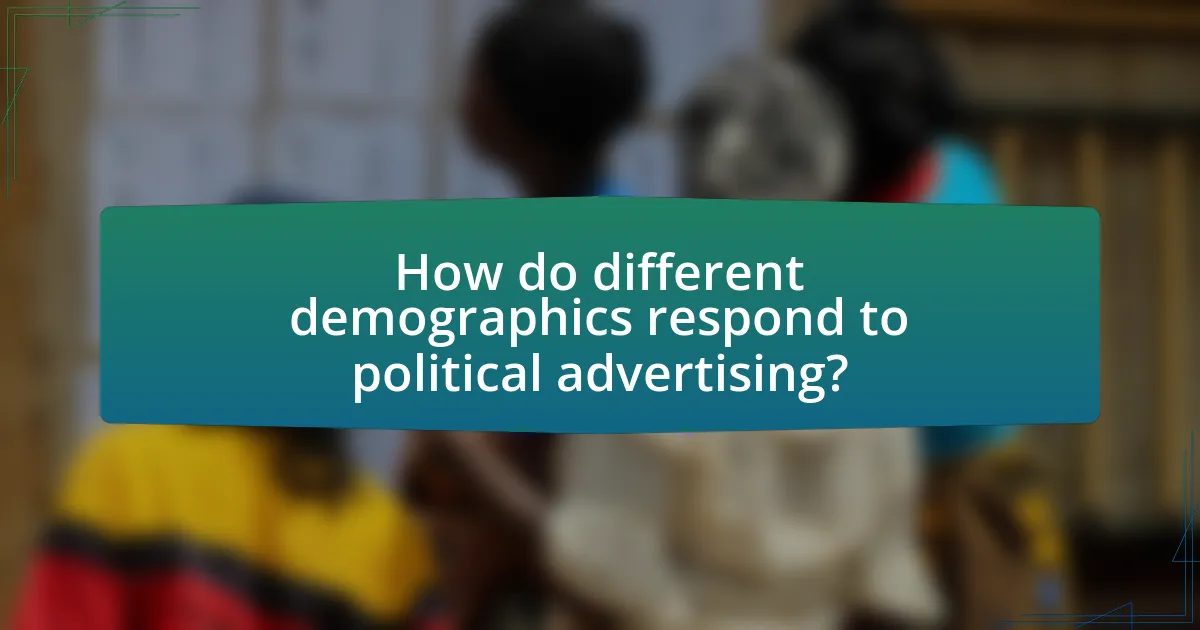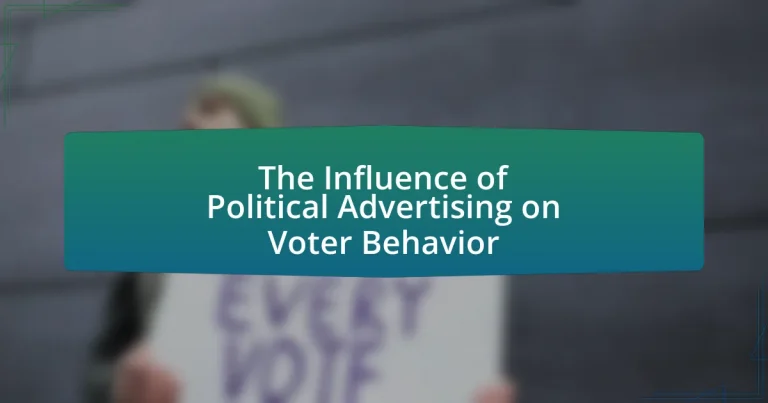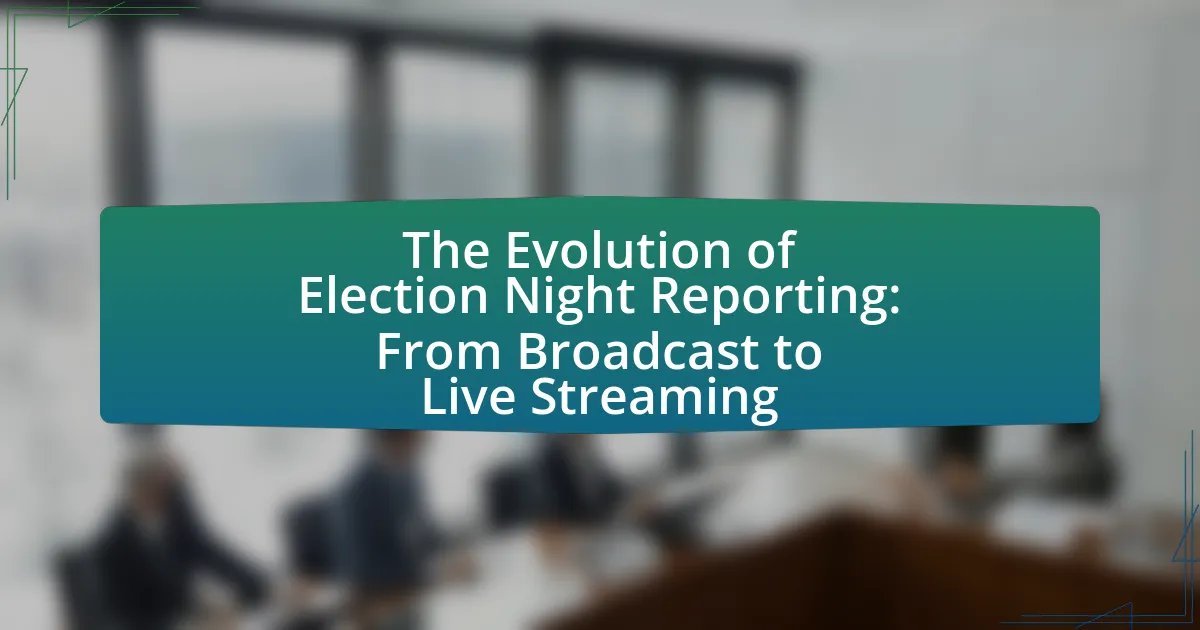The article examines the influence of political advertising on voter behavior, highlighting its role in shaping perceptions, attitudes, and voting decisions. It discusses how targeted advertisements can increase voter turnout by appealing to specific demographics and utilizing emotional appeals. The article also explores the psychological principles behind effective political advertising, the impact of media platforms, and the ethical considerations surrounding misleading advertisements. Additionally, it analyzes how different demographics respond to political ads and the long-term effects of advertising on voter loyalty and public opinion.

What is the Influence of Political Advertising on Voter Behavior?
Political advertising significantly influences voter behavior by shaping perceptions, attitudes, and ultimately voting decisions. Research indicates that targeted advertisements can increase voter turnout by appealing to specific demographics and addressing their concerns. For instance, a study by the Pew Research Center found that 62% of voters reported that political ads influenced their choice in the 2020 election. Additionally, emotional appeals in advertisements have been shown to enhance engagement and retention of information, leading to a greater likelihood of voter mobilization. Thus, the strategic use of political advertising plays a crucial role in determining electoral outcomes.
How does political advertising shape voter perceptions?
Political advertising shapes voter perceptions by influencing their attitudes, beliefs, and behaviors regarding candidates and issues. Research indicates that targeted advertisements can significantly alter how voters perceive a candidate’s competence, trustworthiness, and likability. For instance, a study published in the American Economic Journal found that exposure to negative political ads can lead to a decrease in voter support for the targeted candidate by as much as 10%. Additionally, political ads often utilize emotional appeals and persuasive messaging to create a narrative that resonates with voters, thereby shaping their opinions and decisions at the polls.
What psychological principles underlie political advertising effectiveness?
Psychological principles that underlie political advertising effectiveness include the principles of persuasion, emotional appeal, and social proof. Persuasion techniques, such as the use of ethos, pathos, and logos, help candidates establish credibility, evoke emotions, and present logical arguments, respectively. Emotional appeal is particularly significant, as research indicates that ads eliciting strong emotions, such as fear or hope, can significantly influence voter attitudes and behaviors. For instance, a study by Brader (2006) found that emotionally charged political ads increased voter turnout by creating a sense of urgency and connection to the candidate’s message. Social proof, which refers to the tendency of individuals to conform to the actions or beliefs of others, also plays a crucial role; when voters see others supporting a candidate, they are more likely to align with that choice, as demonstrated in studies on group dynamics and decision-making.
How do emotional appeals in political ads impact voter decisions?
Emotional appeals in political ads significantly influence voter decisions by evoking feelings that can sway opinions and motivate action. Research indicates that ads utilizing emotional content, such as fear or hope, can enhance message retention and increase voter engagement. For instance, a study published in the Journal of Politics found that emotionally charged advertisements led to a 20% increase in voter turnout compared to neutral ads. This demonstrates that emotional appeals effectively resonate with voters, shaping their perceptions and ultimately impacting their electoral choices.
What role does media play in political advertising?
Media serves as a crucial platform for political advertising by facilitating the dissemination of campaign messages to a broad audience. It enables candidates to reach potential voters through various channels, including television, radio, print, and digital platforms. According to a study by the Pew Research Center, 60% of voters reported that they often see political ads on social media, highlighting the media’s role in shaping public perception and influencing voter behavior. Furthermore, the effectiveness of political advertising is amplified by the media’s ability to target specific demographics, allowing campaigns to tailor their messages to resonate with particular voter segments. This targeted approach is supported by data from the American Association of Political Consultants, which indicates that well-executed media strategies can significantly increase voter engagement and turnout.
How do different media platforms affect the reach of political ads?
Different media platforms significantly affect the reach of political ads by varying audience demographics, engagement levels, and distribution methods. For instance, television remains a dominant platform due to its broad reach, with 90% of American households having at least one TV, allowing political ads to target a wide audience effectively. In contrast, social media platforms like Facebook and Twitter enable targeted advertising based on user data, allowing campaigns to reach specific demographics, such as younger voters, more efficiently. Research indicates that ads on social media can achieve higher engagement rates, with Facebook ads generating an average click-through rate of 0.9%, compared to traditional media. Additionally, digital platforms allow for real-time analytics, enabling campaigns to adjust strategies quickly based on performance metrics. Thus, the choice of media platform directly influences the effectiveness and reach of political advertising efforts.
What is the impact of social media on political advertising strategies?
Social media significantly transforms political advertising strategies by enabling targeted messaging and real-time engagement with voters. Political campaigns leverage platforms like Facebook and Twitter to analyze user data, allowing them to tailor advertisements to specific demographics, interests, and behaviors. For instance, a study by the Pew Research Center found that 69% of adults in the U.S. use social media, making it a crucial channel for reaching a broad audience. Additionally, social media facilitates direct interaction between candidates and voters, fostering a sense of community and immediacy that traditional media cannot replicate. This shift has led to increased investment in digital advertising, with political ad spending on social media platforms reaching billions during election cycles, as evidenced by the 2020 U.S. presidential election where over $1 billion was spent on Facebook ads alone.
What are the ethical considerations in political advertising?
Ethical considerations in political advertising include truthfulness, transparency, and the potential for manipulation. Political advertisements must accurately represent candidates and their policies to avoid misleading voters, as false claims can distort public perception and undermine democratic processes. Transparency is crucial; disclosing funding sources and affiliations helps voters understand potential biases. Additionally, the use of emotional appeals and fear tactics raises ethical concerns, as these strategies can manipulate voter emotions rather than inform them. Research indicates that misleading political ads can significantly impact voter behavior, highlighting the importance of ethical standards in maintaining the integrity of electoral processes.
How do misleading advertisements influence voter trust?
Misleading advertisements significantly undermine voter trust by creating confusion and spreading false information about candidates or policies. When voters encounter deceptive claims, they may become skeptical of the political process and question the integrity of all candidates, not just those targeted by the misleading ads. Research from the Pew Research Center indicates that 70% of Americans believe that misleading information in political ads negatively impacts their trust in politicians. This erosion of trust can lead to decreased voter engagement and participation, as individuals may feel disillusioned or manipulated, ultimately affecting electoral outcomes.
What regulations exist to govern political advertising practices?
Regulations governing political advertising practices include the Federal Election Commission (FEC) rules in the United States, which require disclosure of funding sources for political ads and prohibit false statements about candidates. The Bipartisan Campaign Reform Act (BCRA) also restricts the timing and content of political advertisements, particularly those funded by corporations and unions. Additionally, many states have their own laws that further regulate political advertising, including requirements for disclaimers and transparency about sponsorship. These regulations aim to ensure fair practices and protect voters from misleading information.

How do different demographics respond to political advertising?
Different demographics respond to political advertising in varied ways, influenced by factors such as age, gender, education, and socioeconomic status. For instance, younger voters tend to engage more with digital advertising platforms, while older demographics may respond better to traditional media like television. Research indicates that women are more likely to be influenced by emotional appeals in political ads, whereas men may respond more to factual information and policy details. Additionally, individuals with higher education levels often seek out more information and are less swayed by simplistic messaging compared to those with lower educational attainment. A study by the Pew Research Center found that 64% of younger voters reported being influenced by social media ads, highlighting the importance of targeted advertising strategies across different age groups.
What factors influence voter responses to political ads across age groups?
Voter responses to political ads across age groups are influenced by factors such as media consumption habits, cognitive processing abilities, and social identity. Younger voters tend to engage more with digital platforms, making them more responsive to online ads, while older voters often prefer traditional media like television, which affects their ad reception. Cognitive processing varies by age; younger individuals may process emotional appeals more readily, while older voters might focus on factual information. Additionally, social identity, including political affiliation and community ties, shapes how different age groups interpret and respond to political messaging. Research indicates that these factors significantly impact the effectiveness of political advertising across demographics, as evidenced by studies showing varying engagement levels and message retention rates among different age cohorts.
How do younger voters perceive political advertisements compared to older voters?
Younger voters tend to perceive political advertisements as less credible and more manipulative compared to older voters. Research indicates that younger demographics are more skeptical of traditional advertising techniques, often seeking authenticity and relatability in political messaging. A study by the Pew Research Center found that 70% of younger voters prefer candidates who engage with them on social media platforms, reflecting their desire for direct and genuine communication rather than conventional ad formats. In contrast, older voters generally respond more positively to traditional advertisements, viewing them as informative and trustworthy. This difference in perception highlights the evolving landscape of political advertising and its varying effectiveness across age groups.
What role does education level play in interpreting political ads?
Education level significantly influences how individuals interpret political ads. Higher education levels often correlate with enhanced critical thinking skills, enabling individuals to analyze the content, context, and persuasive techniques used in political advertisements more effectively. Research indicates that educated voters are more likely to recognize bias, identify logical fallacies, and assess the credibility of sources presented in ads. For instance, a study by the Pew Research Center found that individuals with a college degree are more adept at discerning factual information from misleading claims in political messaging, leading to more informed voting decisions.
How do cultural backgrounds affect the reception of political advertising?
Cultural backgrounds significantly influence the reception of political advertising by shaping individuals’ values, beliefs, and perceptions. For instance, advertisements that resonate with the cultural norms and traditions of a specific group are more likely to be positively received, while those that clash with these norms may be dismissed or criticized. Research indicates that cultural identity affects how messages are interpreted; for example, a study by the Pew Research Center found that minority groups often respond more favorably to political messages that reflect their cultural experiences and address their specific concerns. This demonstrates that understanding cultural contexts is crucial for effective political advertising, as it can enhance engagement and influence voter behavior.
What strategies are effective in reaching diverse voter populations?
Effective strategies for reaching diverse voter populations include targeted messaging, community engagement, and utilizing multiple communication channels. Targeted messaging involves tailoring political advertisements to resonate with specific cultural values and issues relevant to different demographic groups, which has been shown to increase engagement and turnout. Community engagement strategies, such as collaborating with local organizations and leaders, help build trust and credibility within diverse communities. Additionally, utilizing various communication channels, including social media, traditional media, and in-person events, ensures that messages reach voters where they are most active. Research indicates that campaigns employing these strategies can significantly enhance voter participation among underrepresented groups, as evidenced by the increased turnout rates observed in elections where such approaches were implemented.
How do language and messaging resonate with different cultural groups?
Language and messaging resonate with different cultural groups by reflecting their values, beliefs, and communication styles. For instance, research indicates that political advertisements tailored to specific cultural contexts, such as using local dialects or culturally relevant symbols, significantly enhance engagement and relatability among targeted demographics. A study by the Pew Research Center found that messages emphasizing community and family values resonate more with Hispanic voters, while messages focused on individualism appeal to many white voters. This demonstrates that understanding cultural nuances in language and messaging can effectively influence voter behavior and preferences in political advertising.
What are the implications of demographic responses for political campaigns?
Demographic responses significantly influence political campaigns by shaping strategies, messaging, and resource allocation. Campaigns analyze demographic data, such as age, race, gender, and socioeconomic status, to tailor their outreach efforts effectively. For instance, a study by the Pew Research Center found that younger voters tend to prioritize issues like climate change and social justice, prompting campaigns to focus on these topics to engage this demographic. Additionally, understanding demographic trends allows campaigns to allocate resources efficiently, targeting specific groups through tailored advertisements and outreach efforts. This targeted approach can enhance voter mobilization and increase the likelihood of electoral success.
How can campaigns tailor their advertising to maximize voter engagement?
Campaigns can tailor their advertising to maximize voter engagement by utilizing data-driven strategies that target specific demographics and preferences. By analyzing voter data, campaigns can identify key issues that resonate with different segments of the electorate, allowing them to craft messages that are relevant and compelling. For instance, research from the Pew Research Center indicates that personalized messaging can increase engagement rates significantly, as voters are more likely to respond to content that reflects their values and concerns. Additionally, employing various platforms, such as social media and traditional media, ensures that campaigns reach voters where they are most active, further enhancing engagement.
What lessons can be learned from past political advertising successes and failures?
Past political advertising successes and failures reveal critical lessons about voter engagement and message effectiveness. Successful campaigns, such as Barack Obama’s 2008 election, demonstrated the power of targeted digital advertising and grassroots mobilization, which significantly increased voter turnout among young and minority demographics. Conversely, failures like the 2016 Hillary Clinton campaign highlighted the risks of negative advertising and the importance of authentic messaging, as excessive focus on attacking opponents can alienate potential supporters. These examples underscore the necessity of understanding the audience, crafting relatable narratives, and utilizing data-driven strategies to optimize outreach and influence voter behavior effectively.

What are the long-term effects of political advertising on voter behavior?
Political advertising has significant long-term effects on voter behavior, primarily by shaping perceptions, reinforcing party identification, and influencing electoral outcomes. Research indicates that consistent exposure to political ads can lead to increased voter loyalty and a stronger alignment with specific political ideologies. For instance, a study by the Pew Research Center found that voters who are frequently exposed to political advertising are more likely to develop entrenched views and preferences, which can persist beyond election cycles. Additionally, political ads often create lasting impressions that affect voter turnout and engagement in future elections, as evidenced by data showing that regions with high ad spending see sustained increases in voter participation rates.
How does repeated exposure to political ads influence voter loyalty?
Repeated exposure to political ads significantly enhances voter loyalty by reinforcing candidate recognition and shaping perceptions. Studies indicate that frequent exposure to political messaging increases familiarity, which can lead to a positive bias towards the candidate. For instance, research published in the Journal of Politics found that voters who encountered a candidate’s ads multiple times were more likely to express support for that candidate, demonstrating the mere exposure effect in political contexts. This effect is further supported by data showing that candidates with higher ad frequency often experience increased polling numbers, indicating a direct correlation between ad exposure and voter loyalty.
What is the relationship between ad frequency and voter turnout?
Ad frequency positively influences voter turnout, as increased exposure to political advertisements can enhance voter awareness and engagement. Studies indicate that higher ad frequency correlates with greater voter mobilization, particularly among undecided voters. For instance, research by the Pew Research Center found that individuals exposed to campaign ads multiple times are more likely to participate in elections, demonstrating that consistent messaging reinforces electoral participation.
How do political ads shape long-term political affiliations?
Political ads shape long-term political affiliations by influencing voter perceptions and emotional responses towards candidates and parties. Research indicates that repeated exposure to political advertisements can reinforce existing beliefs and create strong associations between candidates and specific values or issues. For instance, a study by the Pew Research Center found that individuals who frequently viewed political ads were more likely to develop a consistent party identification over time, as these ads often highlight party ideologies and key issues that resonate with target demographics. This consistent messaging can lead to a solidified political identity, as voters align their beliefs with the narratives presented in the ads.
What impact do political advertisements have on public opinion over time?
Political advertisements significantly shape public opinion over time by influencing perceptions, attitudes, and voting behavior. Research indicates that consistent exposure to political ads can lead to changes in voter preferences, particularly during election cycles. For instance, a study by the Pew Research Center found that 62% of voters reported that political ads affected their views on candidates, highlighting the persuasive power of these advertisements. Additionally, longitudinal studies show that negative political ads tend to have a more lasting impact on public opinion than positive ones, often leading to increased polarization among voters. This demonstrates that the strategic use of political advertising can effectively alter the landscape of public opinion as elections approach.
How do shifts in public opinion correlate with major political ad campaigns?
Shifts in public opinion often correlate with major political ad campaigns through the strategic targeting of voter sentiments and the framing of issues. Political ad campaigns are designed to resonate with prevailing public attitudes, and when these campaigns effectively address or influence public concerns, they can lead to measurable changes in opinion polls. For instance, during the 2008 U.S. presidential election, Barack Obama’s campaign utilized targeted advertisements that aligned with the electorate’s desire for change, resulting in a significant shift in voter support, as reflected in a Gallup poll showing a 7-point increase in his favorability following key ad releases. This demonstrates that well-timed and relevant political advertising can directly impact public opinion by shaping perceptions and mobilizing voter engagement.
What role do fact-checking and counter-advertising play in shaping perceptions?
Fact-checking and counter-advertising play a crucial role in shaping perceptions by providing accurate information and challenging misleading narratives. Fact-checking organizations, such as PolitiFact and FactCheck.org, analyze claims made in political advertising, revealing inaccuracies that can influence voter beliefs and decisions. For instance, a study by the Pew Research Center found that 62% of Americans believe fact-checking helps them understand political issues better. Counter-advertising, on the other hand, directly addresses false claims by presenting alternative messages that clarify the truth, thereby mitigating the impact of deceptive ads. Research published in the Journal of Communication indicates that exposure to counter-advertising can significantly reduce the effectiveness of misleading political messages, ultimately guiding voters toward more informed choices.
What strategies can voters use to critically evaluate political advertising?
Voters can critically evaluate political advertising by employing strategies such as fact-checking claims, analyzing the source of the advertisement, and understanding emotional appeals. Fact-checking involves verifying the accuracy of statements made in ads against reliable sources, which helps identify misinformation. Analyzing the source includes considering the organization or individual funding the advertisement, as this can reveal potential biases or agendas. Understanding emotional appeals requires voters to recognize how ads may manipulate feelings to influence opinions, allowing them to assess the validity of the messages presented. These strategies empower voters to make informed decisions based on evidence rather than emotional reactions.
How can voters identify bias in political advertisements?
Voters can identify bias in political advertisements by critically analyzing the language, imagery, and sources of information presented. Biased advertisements often use emotionally charged language, selective statistics, or misleading visuals to sway opinions rather than provide factual information. For instance, a study by the Pew Research Center found that 62% of voters reported encountering misleading information in political ads, highlighting the prevalence of bias. Additionally, voters should verify claims made in advertisements against reputable sources to assess accuracy and context, as independent fact-checking organizations frequently expose biased narratives.
What resources are available for voters to fact-check political claims?
Voters can utilize several resources to fact-check political claims, including websites like FactCheck.org, Snopes.com, and PolitiFact.com. These platforms provide nonpartisan analysis of statements made by politicians and political organizations, often citing original sources and providing context for claims. For instance, FactCheck.org is a project of the Annenberg Public Policy Center and has been operational since 2003, focusing on accuracy in political communication. Snopes.com, established in 1994, investigates rumors and misinformation, while PolitiFact.com, launched in 2007, rates the truthfulness of claims on a scale from “True” to “Pants on Fire.” These resources are essential for voters seeking to verify the accuracy of political information and make informed decisions.




